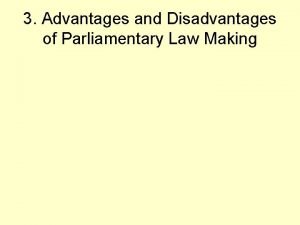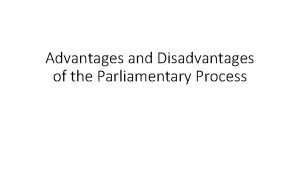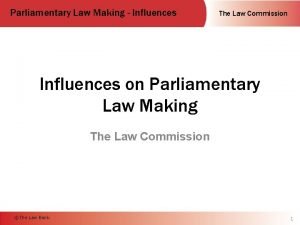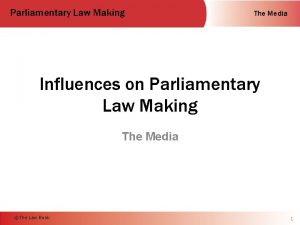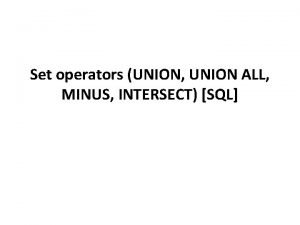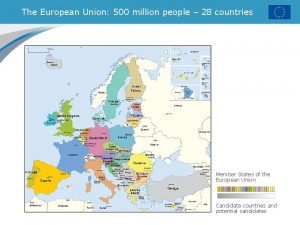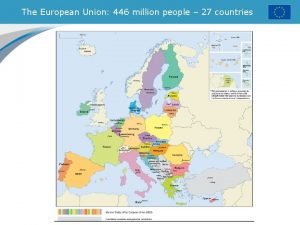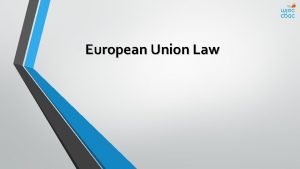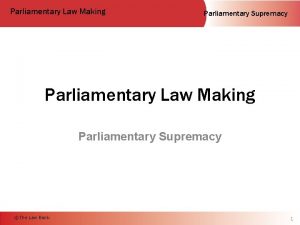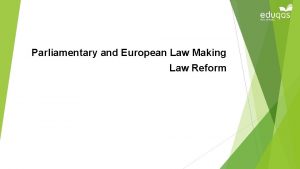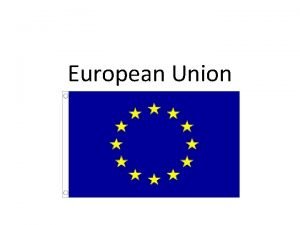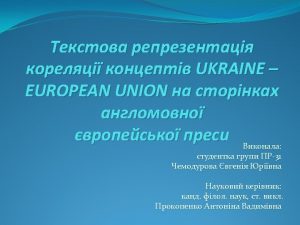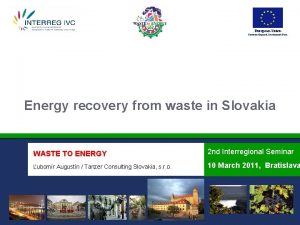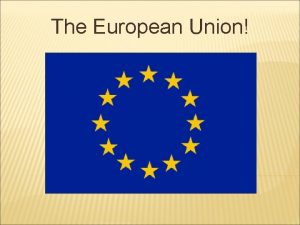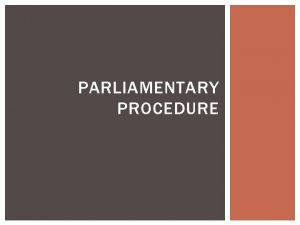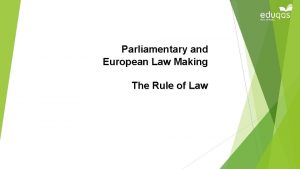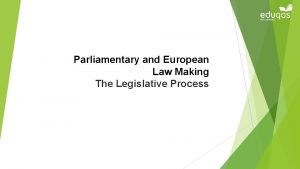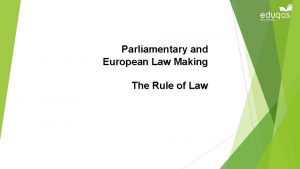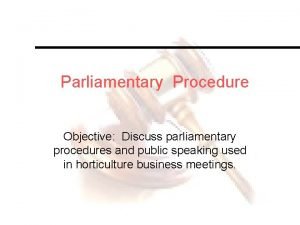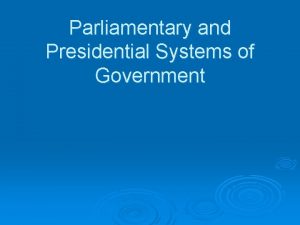Parliamentary and European law making European Union Law




















- Slides: 20

Parliamentary and European law making European Union Law

Objectives Explain the impact of the European Convention on Human Rights on the legal system of England & Wales Explain the main sources of European Law Explain direct applicability and horizontal and vertical direct effect Evaluate the effect of European law on the sovereignty of parliament Discuss impact of Brexit

Sources of European Law There are two main types of EU law; primary and secondary. Primary law are mainly the Treaties, the most important of which was originally the Treaty of Rome itself. Secondary sources are legislation passed by the institutions of the Union under Article 288 (Treaty on the Functioning of the European Union). This secondary legislation is of three types: regulations and directives and decisions. In addition to these two main sources, case law of the CJEU can also be considered a source of law.

Direct Applicability and Direct Effect These two concepts are fundamental to understanding the impact of EU legislation on member states. Direct applicability - a provision of EU law is Directly applicable where it immediately becomes part of the law of each member state. National parliaments cannot reject it, nor do they have to do anything to incorporate it.

Direct Effect Direct effect - a provision of EU law has direct effect where it creates individual rights enforceable in national courts - two main forms of direct effect : vertical - creates individual rights against Governments horizontal - creates individual rights against other individuals, governments and private organisations Indirect effect – National Courts should interpret national law in accordance with relevant EU legislation Law LA 2: European Law

Sources of Union law The Treaties: These are the primary source of Union law. Treaties establish Union’s aims, institutions and legislative procedures. Treaties can be seen as the Union’s constitution. Treaties can have both Horizontal and Vertical Direct Effect provided provision is clear, precise, and unconditional (Van Gend en Loos [1963]) and see Macarthys Ltd v Smith (1979).

Sources of Union law Regulations: Analogy can be made with an English Act of Parliament are Direct Applicable Art 288 of TFEU allows the EU the right to create regulations Binding in their entirety on each member state Can have both Horizontal and Vertical Direct Effect provided ‘Van Gend’ requirements are met (Leonesio v Italy [1973]) Law LA 2: European Law

Sources of European law Directives Not directly applicable Less precisely worded than regulations Binding as to result to be achieved, but leaves form and method of implementation to each member state Can have Vertical Direct Effect only, provided ‘Van Gend’ requirements met -Van Duyn v Home Office (1974) Vertical direct effect means that they impose obligations on the state and not individuals

Cases to discuss/ research for directives and direct effect include: Marshall v Southampton Area Health Authority(1986) – broad definition of ‘state’ Von Colson v Land Nordrhein-Westfalen (1984) Marleasing SA v La Comercial Internacional de Alimentacion SA (1990) CIA Security International SA v Signalson (1996) R (on the application of Mayor and Citizens of Westminster CC) v Mayor of London (2002) R (on the application of Wells) v Secretary of State for Transport, Local Govt and the Regions (2005)

Therefore, Cannot rely on a directive against another individual BUT may still have remedy against state where: Purpose of the directive was to create individual rights, Those rights are clear and precise, There is a link between state’s failure to implement directive and individual’s loss or damage - ‘indirect effect’ - Francovitch v Italy [1992]

Decisions Not directly applicable. A decision may be addressed to a member state, a company or a person. For example, granting export licenses to companies outside of the EU. Can have Vertical Direct Effect only, and only when addressed to a member state (Grad (1970).

How does EU law affect the UK? Because the EU can introduce legislation that automatically forms part of English law, and that creates individual rights which the English courts must enforce This raises the issue of sovereignty - which law, English or EU, will prevail where there is conflict? Of course, we now have the Brexit vote. What impact will this have? Will Parliamentary sovereignty be restored?

How does EU law affect the UK? If the EU is to work, EU law must prevail over inconsistent national law (Costa v ENEL [1964]) Member states have made a transfer of some of their sovereign rights to the EU (Costa) In cases of conflict, national courts must give priority to EU law and disapply inconsistent national law (Minister of Finance v Simmenthal [1978])

The UK s. 2(1) European Communities Act 1972 incorporates EU law into English law. s. 2(4) states that all UK legislation takes effect subject to EU law with the exception of the 1972 Act itself.

The UK Therefore, If Parliament wishes to enact legislation contrary to EU law, it must first expressly amend/repeal s. 2 (Thoburn v Sunderland City Council (2002) – ‘metric martyrs’) – without such express action, the courts will follow EU law (Macarthys v Smith [1979]) The leading case is R v Secretary of State for Transport, ex parte Factortame (1990) duty of a UK court to refuse to apply statutes which are in conflict with directly effective EU law.

As a result, there has been a temporary and limited suspension of sovereignty Parliament retains, under s. 2(4) of the ECA 1972 a power to reassert its full sovereignty However, this would mean leaving the EU Brexit…?

Lord Denning In Bulmer v Bollinger (1974) Denning said: ‘The treaty is like an incoming tide. It flows into the estuaries and up the rivers. It cannot be held back. ’ Law LA 2: European Law

Lord Denning In 1996 Denning said: ‘No longer is European law an incoming tide flowing up the estuaries of England. It is now like a tidal wave bringing down our sea walls and flowing inland over our fields and houses – to the dismay of all. ’ (The Independent 16 th July 1996) Law LA 2: European Law

Test Questions You should now be able to answer the following: Explain the concepts of direct applicability and direct effect. Discuss the Treaties as a source of EU law. Discuss the different forms of EU legislation. Evaluate the impact of EU membership on UK sovereignty. Law LA 2: European Law

Useful Websites https: //europa. eu/european-union/index_en Law LA 2: European Law
 Advantages of parliamentary law making
Advantages of parliamentary law making Advantages of media influence on parliament
Advantages of media influence on parliament Parliamentary law making advantages and disadvantages
Parliamentary law making advantages and disadvantages Influences on law making
Influences on law making How does the media influence parliamentary law making
How does the media influence parliamentary law making Union union all intersect
Union union all intersect European union history
European union history Functions of european union
Functions of european union Co-funded by the erasmus+ programme of the european union
Co-funded by the erasmus+ programme of the european union Co-funded by the erasmus+ programme of the european union
Co-funded by the erasmus+ programme of the european union European union 28 countries
European union 28 countries European union 28 countries
European union 28 countries European union military
European union military Range definition ap human geography
Range definition ap human geography Direct effect eu law
Direct effect eu law This project is funded by the european union
This project is funded by the european union This project is funded by the european union
This project is funded by the european union This project is funded by the european union
This project is funded by the european union This project is funded by the european union
This project is funded by the european union This project is funded by the european union
This project is funded by the european union This project is co-funded by the european union
This project is co-funded by the european union
